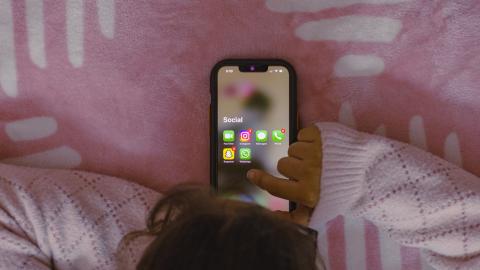Reaction: The risks and benefits of screens for children and young people are small, according to a large review of studies
A review of more than 100 meta-analyses and nearly 2500 studies has analysed the use of screens by children and young people and the consequences for their learning and health. Their conclusions are that, in general, the effects are small and vary according to the type of use and context. The results are published in the journal Nature Human Behaviour.

Perales - Pantallas (EN)
José César Perales
Professor in the department of Experimental Psychology at the University of Granada
The study is an 'umbrella review' of meta-analyses on the possible risks and benefits of screen use in children and adolescents. This is a highly polarised topic with conflicting interests of various stakeholders. Therefore, the aim is precisely to make as objective and systematic an assessment as possible of the existing evidence. As could not be otherwise, the final results coincide with those of previous research of higher quality and call into question those of research of more dubious quality.
The implications are important. On the part where I have a more informed opinion (that of the possible risks), the main conclusion is that the risks of screen use are, in general, quantitatively small or moderate on average and, above all, very heterogeneous. The lack of homogeneity in the results means that talking about risks from screen time is simplistic and does not take into account important moderating variables, for example, whether screen use is supervised or unsupervised, age, gender, or the specific activities performed in the digital environment. It also points to the lack of evidence for drastic measures based solely on usage time and shows that scaremongering about screen use is currently unjustified on the basis of the evidence, and is more ideological than scientific.
As the article itself states: "Our results have several implications for policy and practice. Overall, our findings are consistent with the recommendations of others who suggest that current guidelines may be too simplistic, mischaracterise the strength of the evidence, or fail to recognise important nuances of the issue. Our findings suggest that screen use is a complex issue, with associations based not only on duration and device type, but also on content and the environment in which exposure occurs. Many current guidelines simplify this complex relationship as something to be minimised. We suggest that future guidelines should take into account the complexity of the issue and provide parents and clinicians with specific information to weigh the pros and cons of screen interactions".
The study has several important methodological strengths. The main one is that, before integrating all previous meta-analyses, it makes a systematic assessment of the statistical credibility of each of them. The big problem with meta-analyses is that the methodology of many of them is questionable and, even when they follow a systematic methodology, the studies on which these meta-analyses are based are not very credible because there is a significant publication bias. Selecting only meta-analyses that do not have these problems makes the final conclusions considerably stronger.
Another important strength is the adoption of open science measures, with a pre-registered methodology, and with all the analysis code and data used available to any researcher who wants to reproduce the search and selection procedure of studies and the analyses performed.
On the other hand, all studies of this type have limitations that derive from the decisions made when integrating the available information. In this case, methodological flexibility is minimised by the fact that all important aspects of the procedure have been pre-registered, and the limitations of adopting this methodology rather than another are appropriately acknowledged in the relevant section of the article.
Another issue is the limitations of the studies (meta-analyses and individual studies on which they are based) included in this umbrella review. In this field there are, for example, important problems related to the measurement of time of use (which is mainly based on self-reports whose reliability is not proven), and there is a lot of heterogeneity in defining possible risks and benefits. Therefore, just because the available evidence is poor, it does not mean that these risks or benefits are really small. It is simply that the evidence, even selecting the highest quality studies, is insufficient to be conclusive about the existence of substantial effects of screen use on well-being and health. Just as it cannot be concluded that such effects exist, neither can it be concluded that they do not exist. Absence of evidence" does not imply that there is "evidence of absence". The final conclusion should be that it is too early to justify disproportionate alarm about screen use and that there is a need to improve the way screen research is conducted.
Ferrero - Pantallas (EN)
Marta Ferrero
Professor and Vice-Dean of Research and Transfer at the Faculty of Teacher Training and Education of the Universidad Autónoma de Madrid.
Although it would be interesting to know how they have specifically carried out some analyses, for example when calculating publication bias, the study follows all the steps that a rigorous umbrella review should follow and, in fact, it is published in a scientific journal with a high impact in the field of psychology, which in itself indicates the quality of the publication. Some signs of its quality are the search procedure used, which is shown in the flow chart in Figure 1, and the classification of the articles according to their quality based on rigorous criteria developed by the authors of the team and whose data are shown in Table 1.
As the study itself advises, more studies with different samples (e.g. population of different ages) and with specific outcomes (e.g. effect of augmented reality on experimental science learning) are still needed in order to reach conclusive findings that can inform educational or health practice. I think its main novelty, together with the fact that it is the first meta-analysis of meta-analyses on the impact of screens, is to call for caution before the drastic messages that are being launched in various media and social networks.
The limitations are marked by the lack of sufficient quality studies, which the authors themselves highlight.
Sanders et al.
- Research article
- Peer reviewed
- People
- Systematic review



